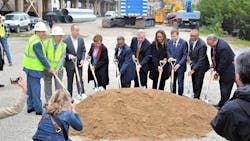CTA begins Phase One of $2.1-billion Red and Purple Modernization Project
The Chicago Transit Authority (CTA) and the city of Chicago officially began work on the largest reconstruction project in the agency’s history, the Red and Purple Modernization (RPM) Project Phase One, with a groundbreaking ceremony on Oct. 2.
The project will modernize and replace rail structures and stations that have been in service for a century along CTA’s busiest line, the Red Line, that serves more than 30 percent of the agency’s rail customers. CTA's Red Line provides more than 200,000 rides on average each weekday and more than 70 million rides a year, serving some of the most densely populated neighborhoods in the nation.
“Today is a historic day for Chicago transit as we begin the largest project in CTA history to modernize CTA rail service for the next century and rebuild the Red Line, the CTA’s busiest line,” said Chicago Mayor Lori E. Lightfoot. "Public transit is the great connector of our city — and with this monumental project, we are building on our obligation to ensure Chicago’s transportation network is accessible, reliable and affordable for all residents of this city so that our neighborhoods and communities are connected to jobs, education and opportunity."
The entire RPM project will impact a 9.6-mile stretch of track and will be built in phases. The $2.1 billion Phase One consists of two main components: Red-Purple Bypass Project and the Lawrence to Bryn Mawr Modernization Project.
The new Red-Purple Bypass is designed to unclog a 100-year-old junction where Red, Purple and Brown Line trains currently intersect. CTA says the bypass is a key piece of the RPM that will allow for train service to be increased over the next 60 to 80 years. All northbound CTA Brown Line trains must cross over four tracks used by Red and Purple line trains at the current flat rail intersection. The new bypass will allow Brown Line trains to operate along dedicated tracks above the Red and Purple line tracks. In addition to removing a bottleneck in the CTA’s rail system, the bypass project will allow for up to eight additional Red Line trains per hour during rush periods and save customers an estimated 500,000 travel hours each year.
The second main component of the RPM Phase One will see the complete rebuilding of the Lawrence, Argyle, Berwyn and Bryn Mawr stations and all the tracks and support structures for more than a mile adjacent to the stations. The modernization efforts include making the stations fully ADA accessible and will include additional amenities such as elevators, wider platforms and real-time information boards.
“CTA customers will see a significant improvement in service with increased accessibility to rail service, less crowding on trains and rail platforms and shorter commute times,” said CTA President Dorval Carter. “The benefits of this project extend beyond riders of the Red Line to Chicago’s neighborhoods and small businesses across the city through training, job and contract opportunities that will be a model for future CTA projects like the Red Line Extension.”
CTA signed a Full Funding Grant Agreement with the Federal Transit Administration in 2017 for $957 million in Core Capacity Funds for the RPM Phase One. The remaining Phase One funding includes a federal $125 million Congestion Mitigation and Air Quality Improvement grant from the Chicago Metropolitan Agency for Planning and $622 million in Transit TIF funds from the city of Chicago and CTA financing.
All work on RPM Phase One will be completed in 2025 with the Red-Purple Bypass project set to be completed by the end of 2021. The reconstruction of the Red and Purple line track structure between Belmont and Newport/Cornelia is expected to be completed by the end of 2024.
This fall, CTA’s contractor, Walsh-Fluor Design-Build Team, will begin constructing new track structure foundations in the Lakeview community for the bypass bridge that will allow Kimball-bound (northbound) Brown Line trains to cross over north- and southbound Red and Purple Line tracks just north of Belmont station.
The Walsh-Fluor team says it closely examined methods to mitigate disruption related to construction. The plans include components and construction methods to reduce the impact on neighborhood residents, businesses, environment and traffic.
“The Red and Purple Lines are part of the daily lives of thousands of Chicagoans,” said Matthew Walsh, co-chairman of Walsh Construction. “We’re committed to enhancing this vital transit link and delivering reliable, safe and high-quality infrastructure to the citizens of Chicago.”

Mischa Wanek-Libman | Group Editorial Director
Mischa Wanek-Libman is director of communications with Transdev North America. She has more than 20 years of experience working in the transportation industry covering construction projects, engineering challenges, transit and rail operations and best practices.
Wanek-Libman has held top editorial positions at freight rail and public transportation business-to-business publications including as editor-in-chief and editorial director of Mass Transit from 2018-2024. She has been recognized for editorial excellence through her individual work, as well as for collaborative content.
She is an active member of the American Public Transportation Association's Marketing and Communications Committee and served 14 years as a Board Observer on the National Railroad Construction and Maintenance Association (NRC) Board of Directors.
She is a graduate of Drake University in Des Moines, Iowa, where she earned a Bachelor of Arts degree in Journalism and Mass Communication.


